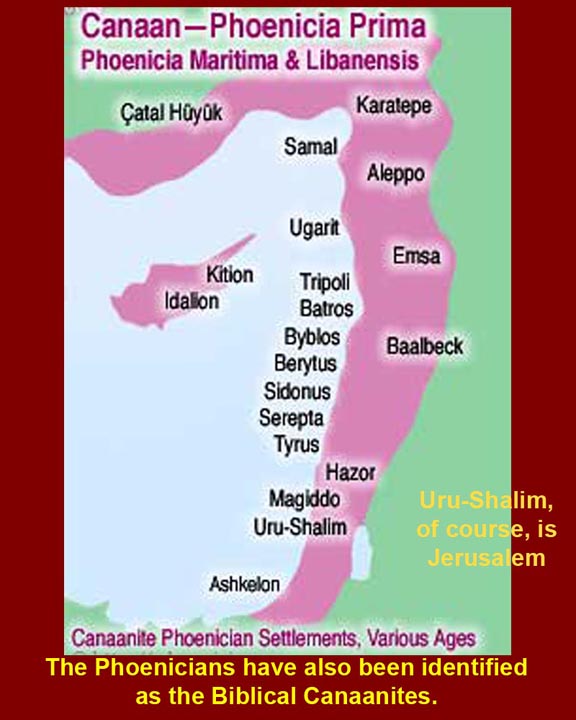
http://www.mmdtkw.org/CNAf0201PhoeniciaPrima.jpg
The Phoenicians, who may have originated in the Persian Gulf, settled in the coast of what is now Lebanon. The two most active cities were Tyre and Sidon, and they and others first colonized the middle east and Cyprus. By 1100 BC they were busily setting up trading posts at 20 mile intervals along the entire Mediterranean coast and beyond, into the Atlantic, on the African and European coast.
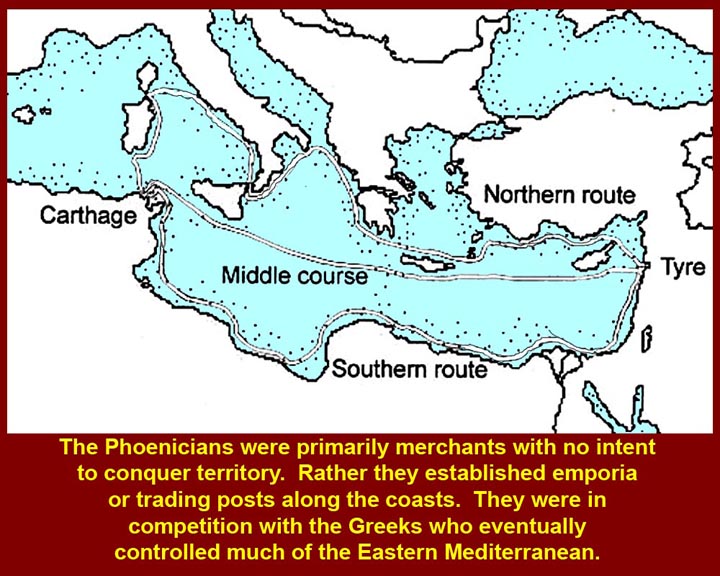
http://www.mmdtkw.org/CNAf0202PhoenicianTrade.jpg
There were three major routes. What the Phoenicians wanted most was metals. The first post that became a permanent colony was Gades (later Cadiz) on the Spanish Coast near Gibraltar where the Phoenicians traded finished manufacture items for Iberian silver.
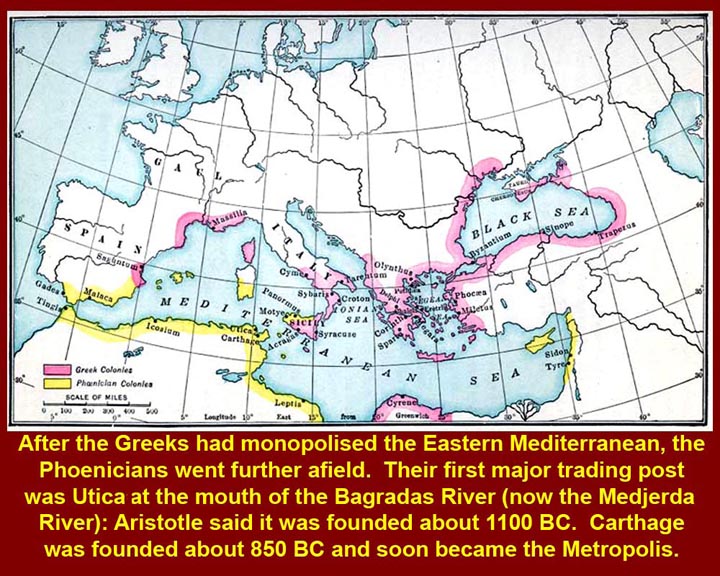
http://www.mmdtkw.org/CNAf0203PhonicianColonies.jpg
The Greeks tied up trade with the eastern end of the North African coast -- Egypt, after all, was ruled by Ptolomeic Greeks. The Sidonian Phoenicians set up further west with their first big trade center at Utica on the Gulf of Tunis at the mouth of the Bagradas River (now the Medjerda River) around 1100 BC. About 300 years later, the Tyrians founded Carthage on a hill further south on the Gulf of Tunis, and competition reared its head. Because Tyre was richer than Sidon, the Carthaginians got more support from their home town. Soon after Carthage was founded, Utica was second fiddle, and Utica never forgave Carthage. During various wars, including the Punic Wars with Rome, Utica routinely sided with the enemies of Carthage. The Greeks allowed Phoenician and, later, Carthaginian traders to operate within the Greek areas of the Eastern Mediterranean, but the two groups were deadly enemies in the west. Eventually there was war between the Greek and Carthaginian cities in Sicily and continuation of that is what gave the Romans their excuse for the First Punic War. The Second Punic War started when Hannibal took the former Greek colony of Saguntum on the Spanish Mediterranean coast, which had passed into Roman protection.
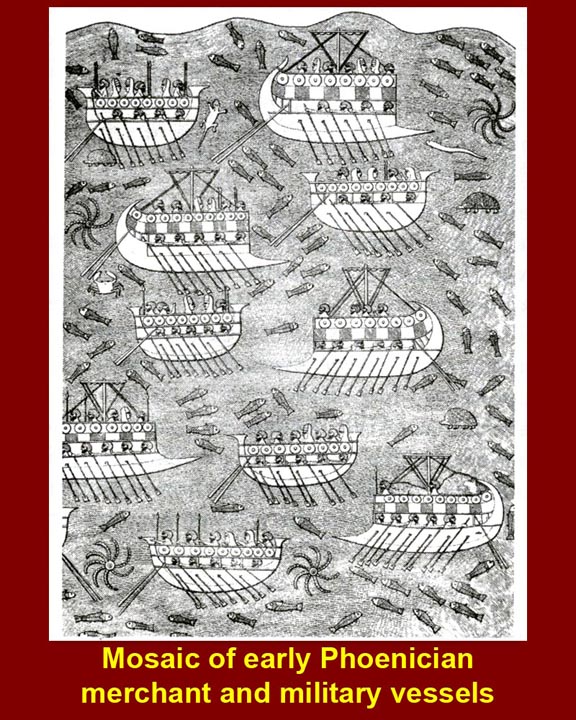
http://www.mmdtkw.org/CNAf0204PhoenicianShips.jpg
Phoenician trade depended on an active navy and merchant marine. This early mosaic shows both sides of the equation. The ships with two rounded ends were merchantmen and those with a pointed prow were navy. The pointed end is a metal ram and is what the Romans eventually called a rostrum. Rostra, which were taken as trophies and were mounted on the front of the speakers platforms in Roman municipal forums, became the turf of over-excited speakers: hence our use of the word rostrum in English.
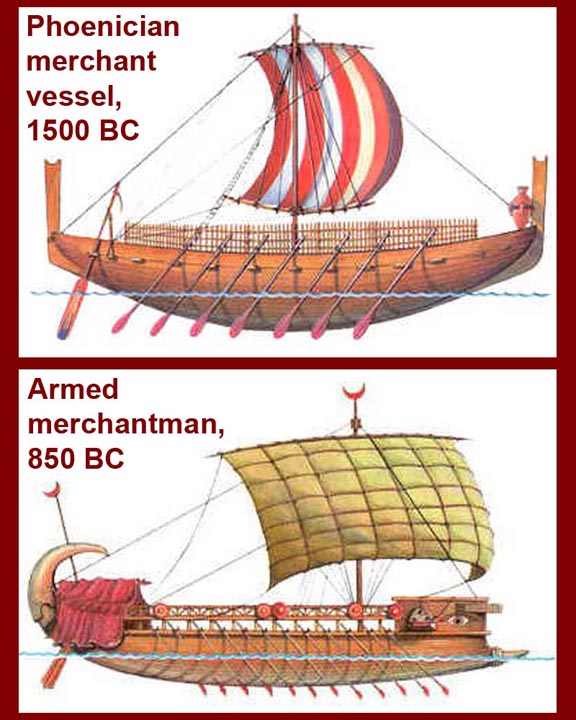
http://www.mmdtkw.org/CNAf0205ShipsMerchant.jpg
Merchant ships eventually were armed and double decked. The upper deck offered some protection from pirate or enemy missiles and also increased
cargo capacity. Merchant ships carried rostra, but usually not of the size or strength of those on the warships. The Phoenicians were great innovators in ship design, but their ships were soon copied (or in the case of the Romans, copied much later).
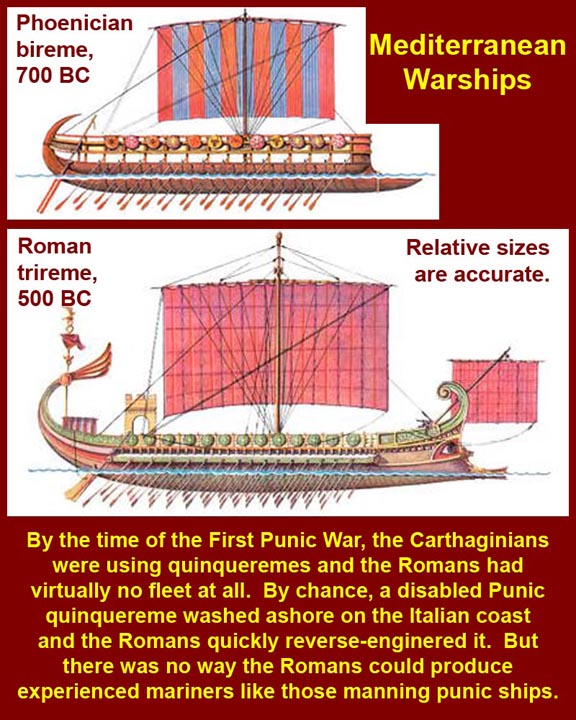
http://www.mmdtkw.org/CNAf0206aWarshipsBC.jpg
If one bank of oars was good, two or three would certainly be better. Because the Romans eventually won the whole Mediterranean, the ships all ended up with Latin designations: unireme, bireme, trireme, quadrereme, quinquerime, etc. (using the Roman names for the numbers along with remus, which was the Latin word for oar. The Ptolomies in Egypt and some later Emperors actually had ceremonial triginteremes, which, despite their name, didn't have thirty banks of oars. Nobody really knows how the oars were arrange on anything but uni-, bi-, and triremes, but its assumed that the higher numbers ("fours", "fives", "sixes", etc.) had multiple rowers per oar rather than more and more banks of oars. A quadrereme would have two banks of oars on each side with to men per oar or three banks of oars per side, one of the banks having two men on each oar. At least, those are the prevalent theories. To avoid interference among the banks of oars, the ships had wide overhangs above the water.
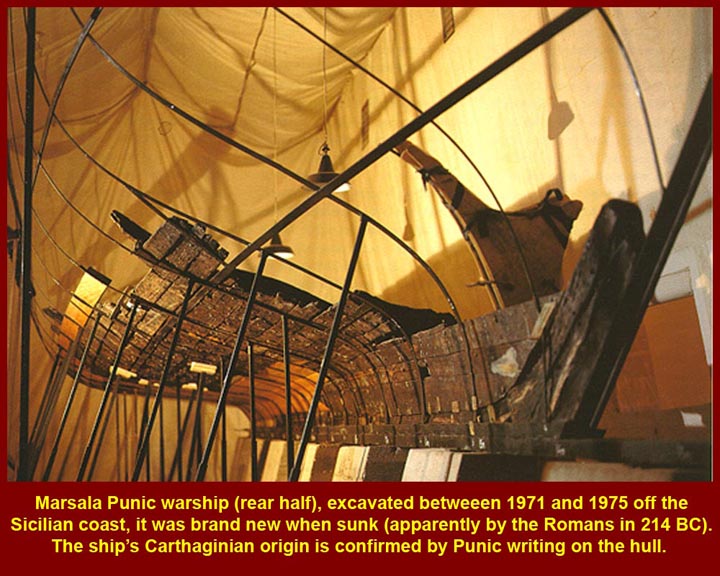
http://www.mmdtkw.org/CNAf0206bMarsalaPunicShip.jpg
The back end of this Punic ship was raised from the sea off Marsala in Sicily in 1971 and put on display in a small local museum after for years of conservation and preservation work. We know it was a Punic ship because of Punic inscriptions that were painted on the sides. The front end of the ship was lost to tides and currents over the millennia, but the stern was buried in silt. It appears to have been brand new when sunk, apparently by the Romans in a battle fought there in 214 BC during the Second Punic War.
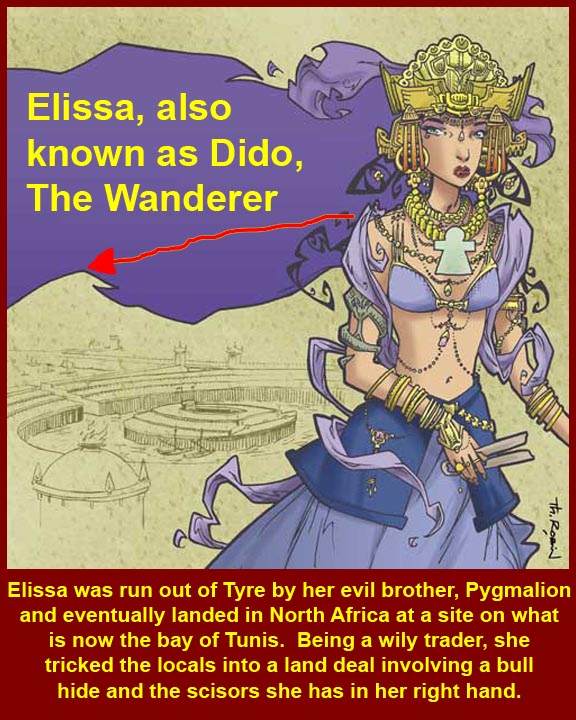
http://www.mmdtkw.org/CNAf0207Elissa.jpg
According to Greek accounts, Elissa, a.k.a. Dido ("The Wanderer"), founded Carthage in 814 or 813 BC after escaping from her evil younger brother, Pygmalion, who had usurped her throne after their father died. The Romans later anachronized the situation entangling their own mythical forefather, Aeneas, with the Dido Legend.
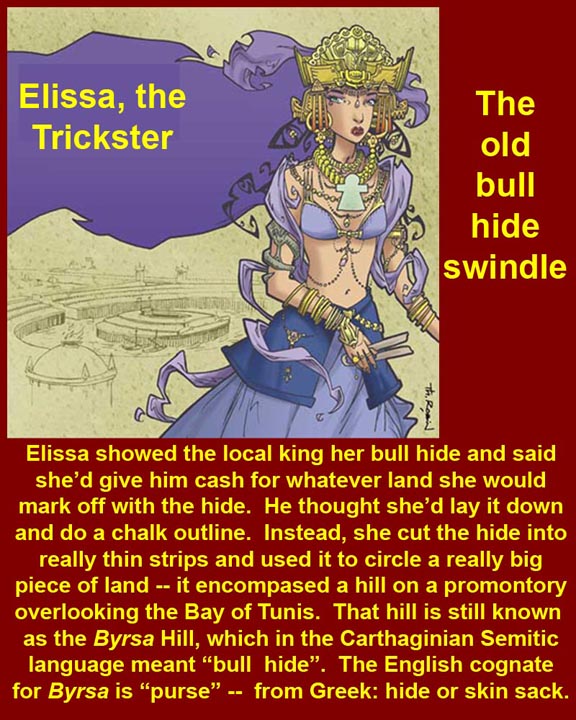
http://www.mmdtkw.org/CNAf0208Elissa.jpg
Elissa/Dido cut a deal (and a bull-hide) to get some land from the locals. The mythical swindle is thought to be an indication of the craftiness of the newly arrived Tyrians.
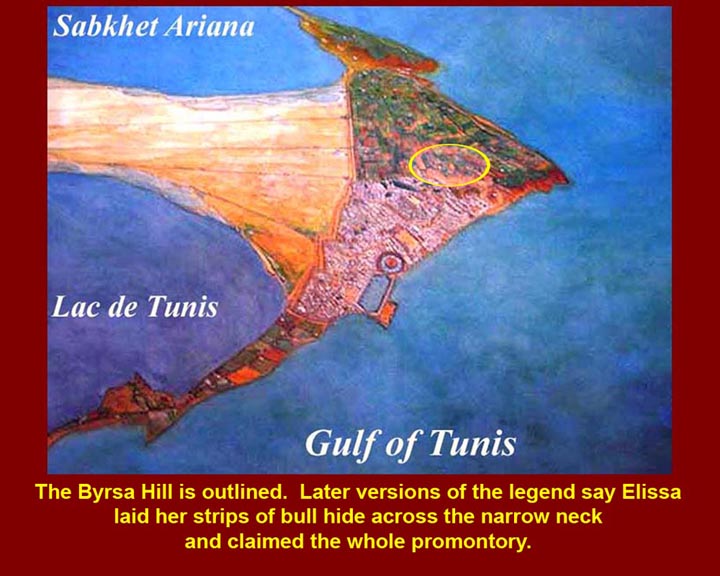
http://www.mmdtkw.org/CNAf0209ByrsaHill.jpg
Dido cut her bull-hide into very thin strips and used the strips to measure off the Byrsa Hill, the high point on an easily defensible promontory on the Gulf of Tunis. The legend may well have originated with the Greeks: the Greek word Byrsa means oxhide. Our word "purse" comes from the same source -- the Greek word can also mean a leather or hide bag.
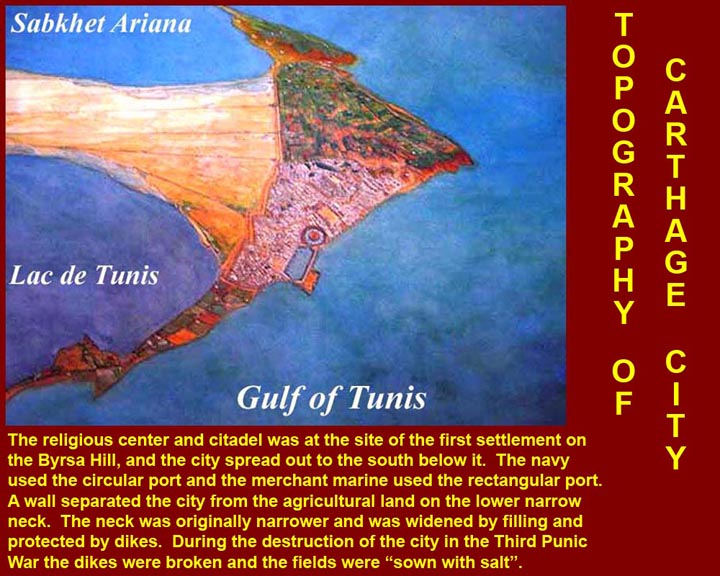
http://www.mmdtkw.org/CNAf0210KiryatHaDasht.jpg
The new city that spread out to the south of the Byrsa Hill was called Kart Hadasht (or Kiryat Ha Dasht), which, interestingly enough, meant "New City" in the Phoenician Semitic language. There were eventually two connected ports, an outer rectangular port for the merchant marine and a circular port for the Navy. The outer port was built first. On the laundward side of the city there were a series of defensive fortifications, outside of which were low fields that were protected by dikes. The dikes were gradually extended outward, and landfil was used to create more fields for agriculture. It's thought that these were the fields "sown with salt" by the Romans after the destruction of Carthage in the Third Punic War: the Romans simply broke the Dikes.
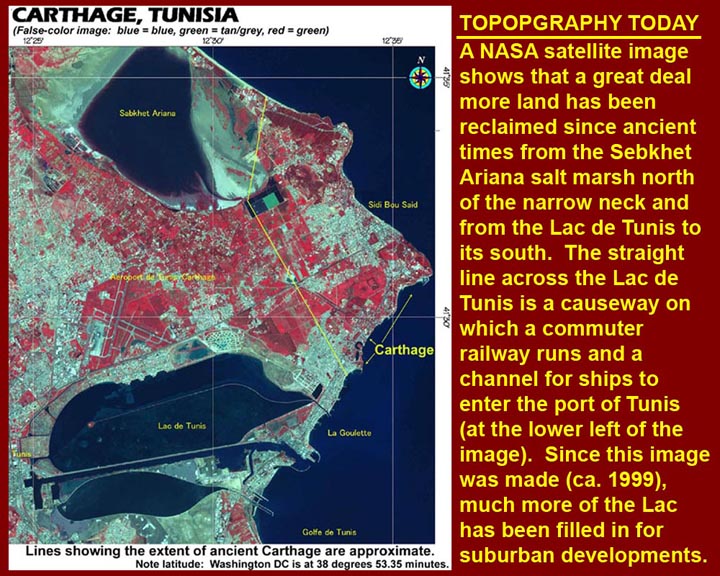
http://www.mmdtkw.org/CNAf0211CarthageTopoToday.jpg
The Romans rebuilt Carthage during the reign of Augustus, one hundred years after the Third Punic War. In the years since then, the metropolis shifted to the back of the Lac de Tunis -- the modern city of Tunis. Much landfilling has also occurred, and the narrow neck that once connected Carthage to the mainland is now much wider. Since the satellite image was made several years ago, there has been an acceleration of the landfill to accommodate burgeoning suburban growth.
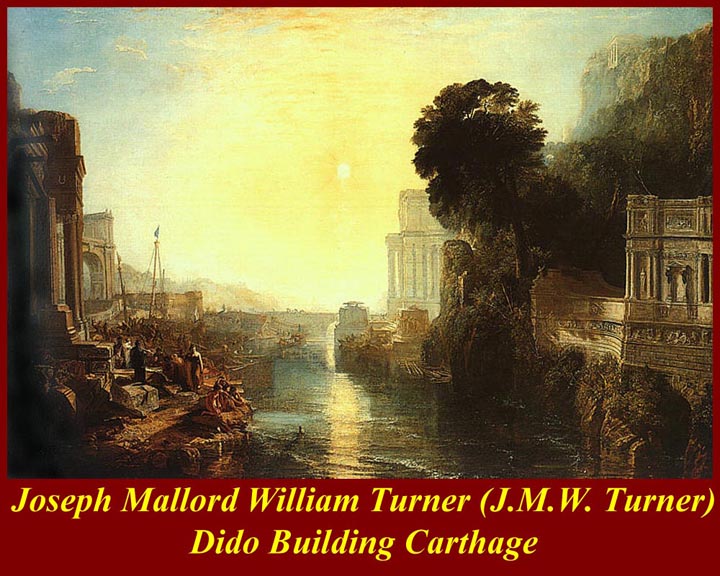
http://www.mmdtkw.org/CNAf0212DidoBuildingCarthageTurner.jpg
Turner's love for this painting (Dido building Carthage; or, the Rise of The Carthaginian Empire, 1815 ) was so great that he asked to be wrapped in it in his coffin. His executor threatened to have him exhumed to recover the painting for the estate, and Turner changed his will. The original request is displayed in the London National Gallery near the painting.
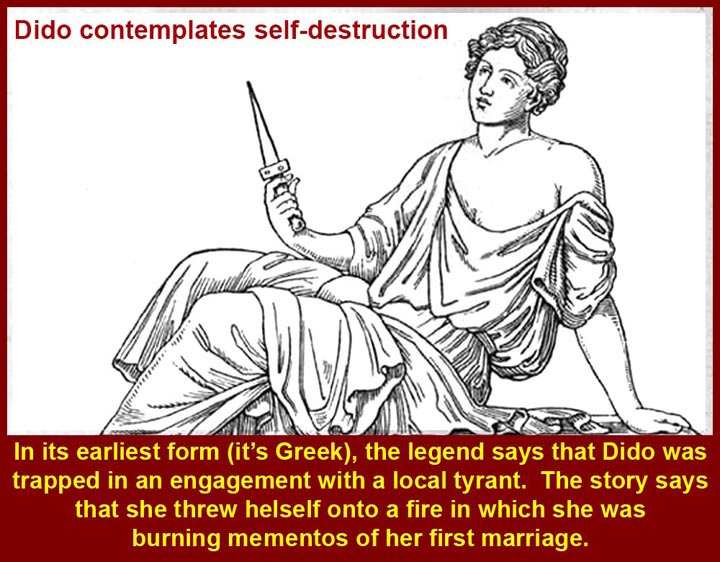
http://www.mmdtkw.org/CNAf0213DidoPlansSuicide.jpg
In the Greek version of the Dido legend, after founding Carthage, she is trapped into a marriage with a local chieftain. To avoid him, she throws herself onto a pyre on which she was burning her mementos of her firs marriage (back in Tyre.) Here she's having a "to be or not to be" moment.
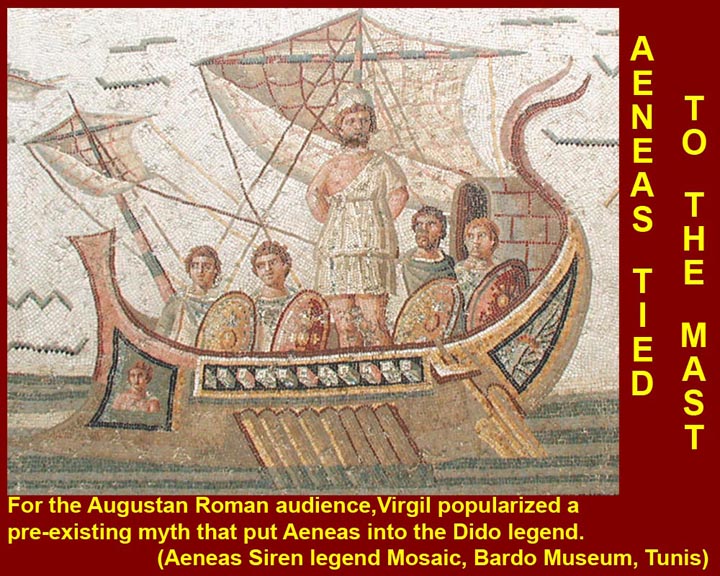
http://www.mmdtkw.org/CNAf0214AeneasSirenMosaic.jpg
As mentioned above, the Romans anachronistically tied Aeneas into the Dido legend -- his story was closer to 1200 BC than to 814 BC. In Roman Carthage, Aeneas was a popular subject of decorative arts. This is part of a large mosaic from a Roman Villa, now in the Bardo Museum in suburban Tunis City. It shows Aeneas tied to the mast of his ship so that he can hear the Sirens but not be drawn to them. The crew had their ears stopped with wax so they wouldn't hear the Sirens.
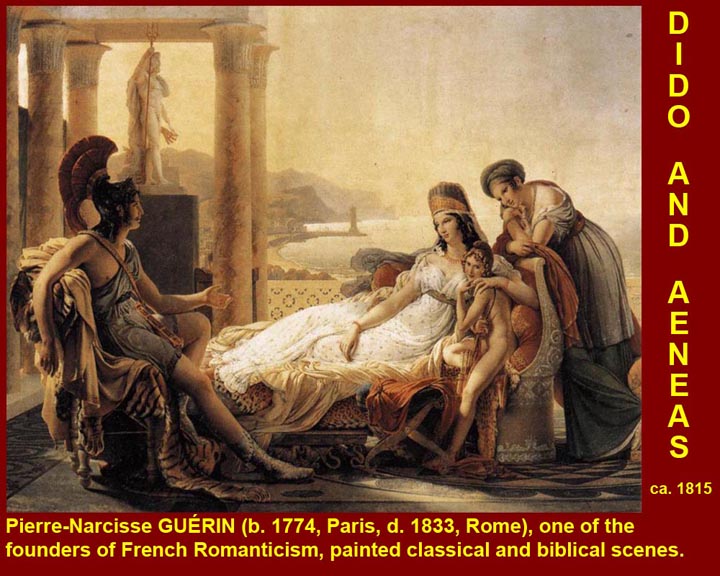
http://www.mmdtkw.org/CNAf0215DidoAeneasGuerin.jpg
Aeneas fascinates Dido of stories of his past: Virgil's exposition of the early Aeneas legend -- an 1815 painting by French Romanticist, Pierre-Narcisse Guerin.
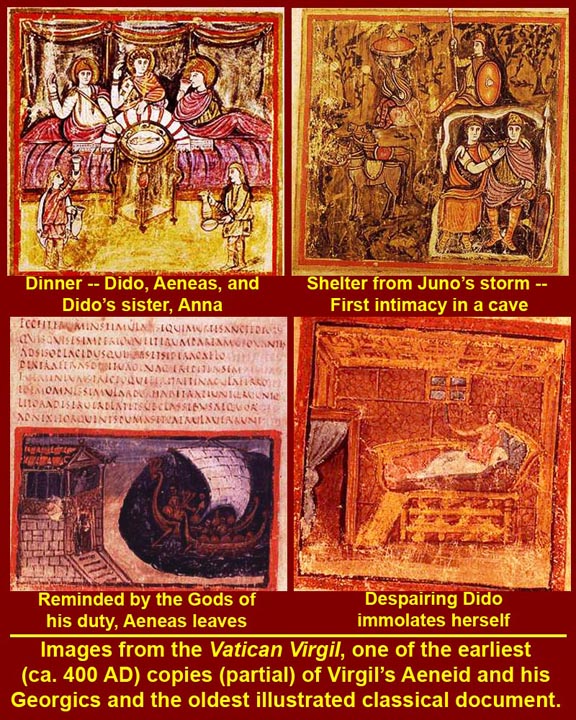
http://www.mmdtkw.org/CNAf0216VaticanVirgilIllustrations.jpg
The "Vatican Virgil" is the earliest known illustrated classical work. Less that one fifth of the original 400-odd pages of the Aeneid and the Georgics survive. The four illustration here are: a dinner (Dido, Aeneas, and Dido's sister Anna); Dido and Aeneas shelter in a cave from a thunderstorm (provided by Juno to throw them together) where their passions overcome them; Aeneas leaves after being reminded by the gods of his mission for found a new kingdom in Italy, and; Dido in her act of immolation.
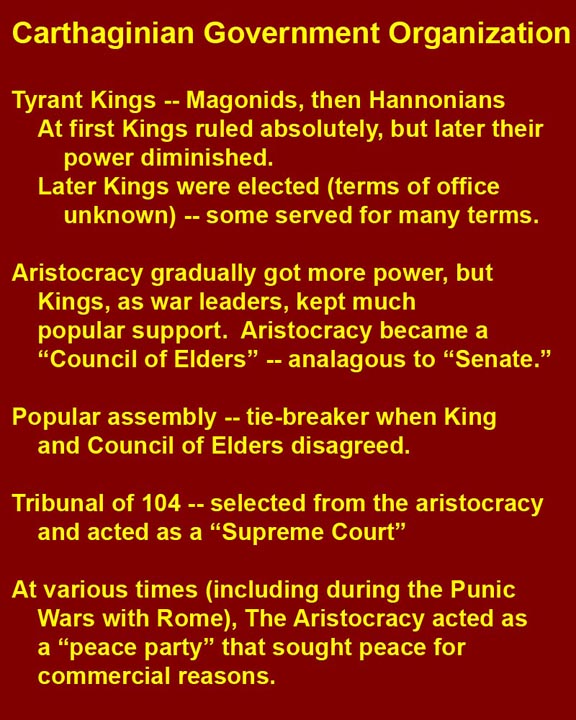
http://www.mmdtkw.org/CNAf0217CarthageGovtOrg.jpg
A one page cheat-sheet on Carthaginian government organization.
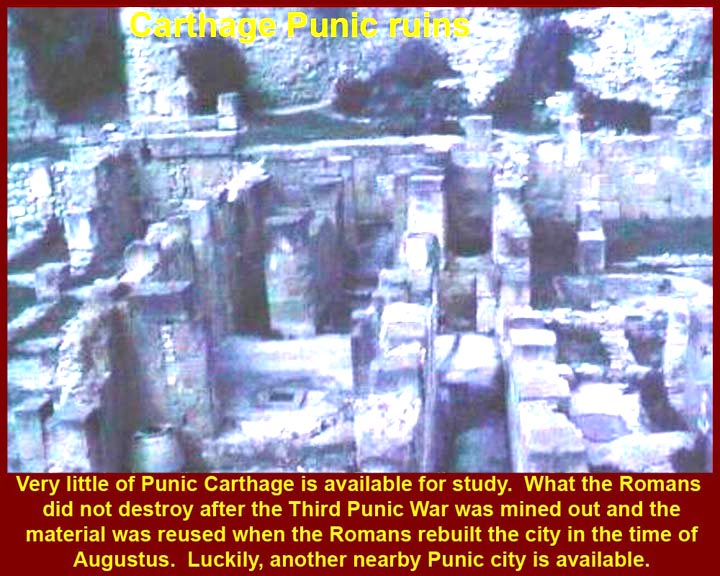
http://www.mmdtkw.org/CNAf0218PunicCarthage.jpg
Little of Punic Carthage is left for excavation -- it was all either destroyed at the end of the Third Punic War or mined out for construction materials when the city was rebuilt in the Roman style during the reign of Augustus. Luckily, a nearby Punic town, Kerkouane on the Cap Bon Peninsula, survived the general destruction and was never over-built.
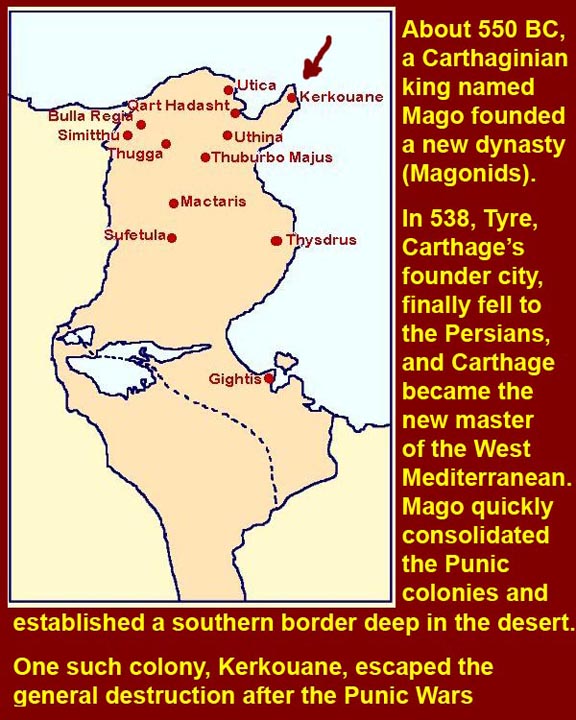
http://www.mmdtkw.org/CNAf0219KerkouaneLocator.jpg
The map shows the location of Kerkouane, one of the Phoenician colonies taken over by the Magonid Kings after the fall of Tyre first to the Assyrians in 575 and then to the Persians in 538. Mago and his successors also dug a defensive trench across the Sahara and the desert plateaus.
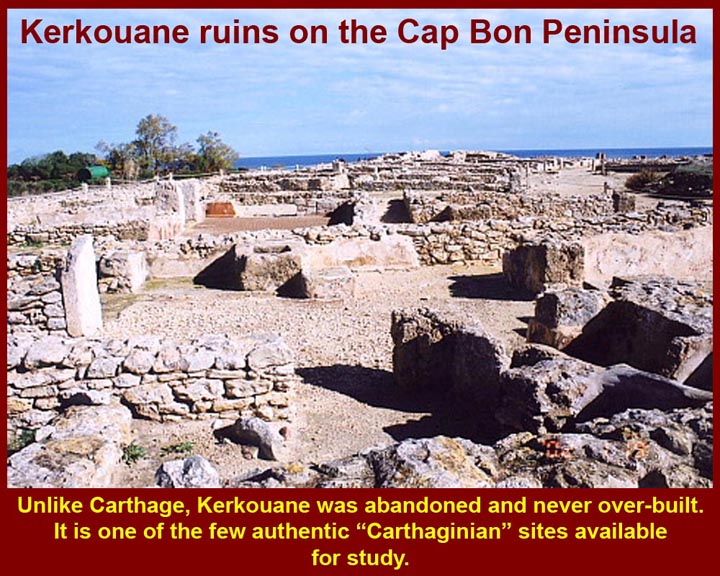
http://www.mmdtkw.org/CNAf0220KerkouanePunicRuins.jpg
The only authentic urban Punic/Carthaginian ruins in North Africa are at Kerkouane.
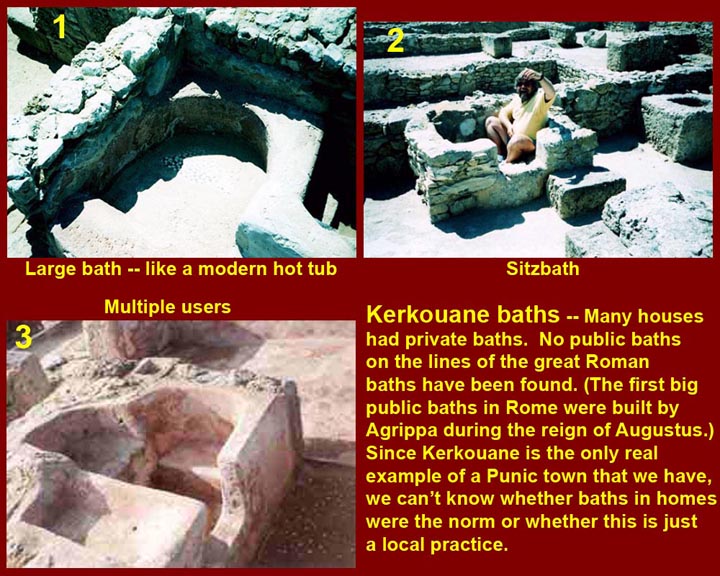
http://www.mmdtkw.org/CNAf0221KerkouaneBaths.jpg
The common characteristic of Punic houses in Kerkouane were their well designed and well preserved private baths. The hydraulic plaster, with which they were constructed, was extremely durable.
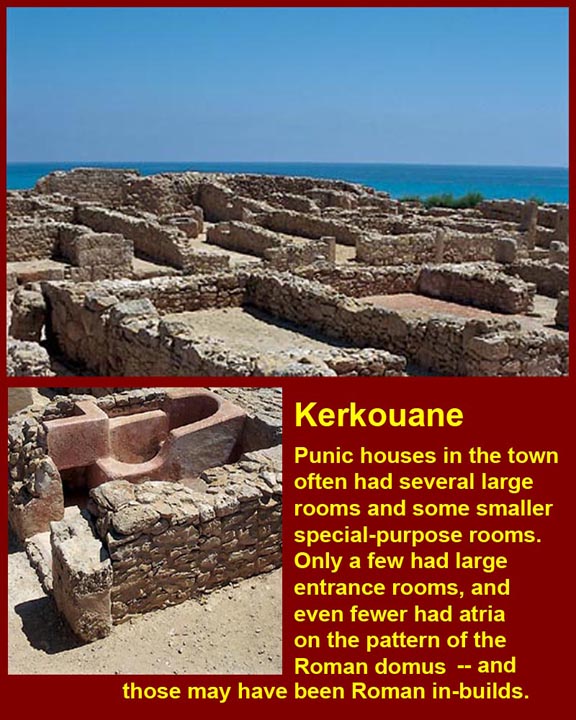
http://www.mmdtkw.org/CNAf0222KerkouaneHouses.jpg
If the Kerkouane examples are any indication, Punic homes had several large rooms surrounded by a few smaller more specialized spaces, including, of course, baths.
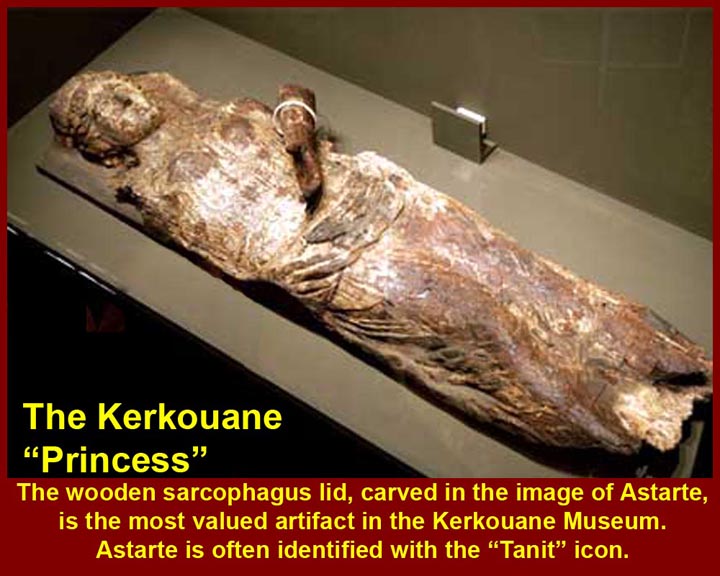
http://www.mmdtkw.org/CNAf0223KerkouanePrincess.jpg
The "Princess" is a wooden sarcophagus lid carved in the likeness of Tanit/Astarte. It is the only known example and is, naturally, the pride of the small Kerkouane museum.
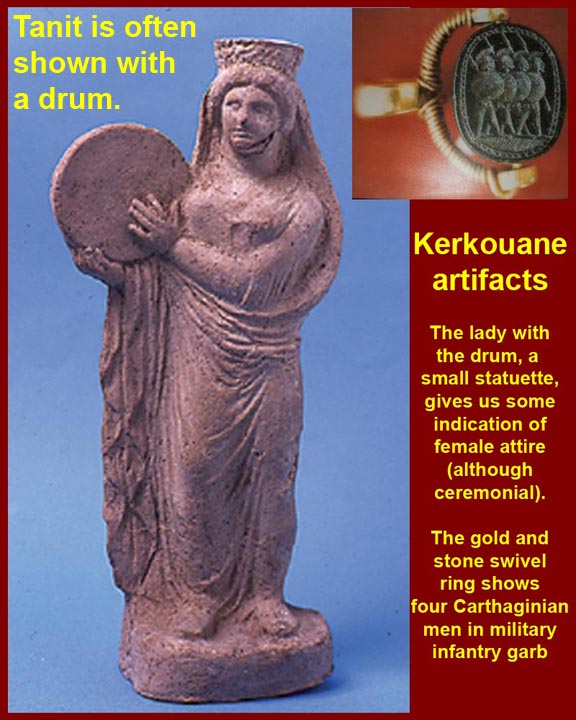
http://www.mmdtkw.org/CNAf0224aDrumLadyRing.jpg
A figurine of a woman with a drum or "tambourine" (perhaps Tanit/Astarte) and a swivel seal ring, one side of which shows four Punic infantrymen from the Kerkouane museum. Most of the Punic sites in North Africa have small museums where some artifacts (those not claimed by the Bardo national museum) are on display.
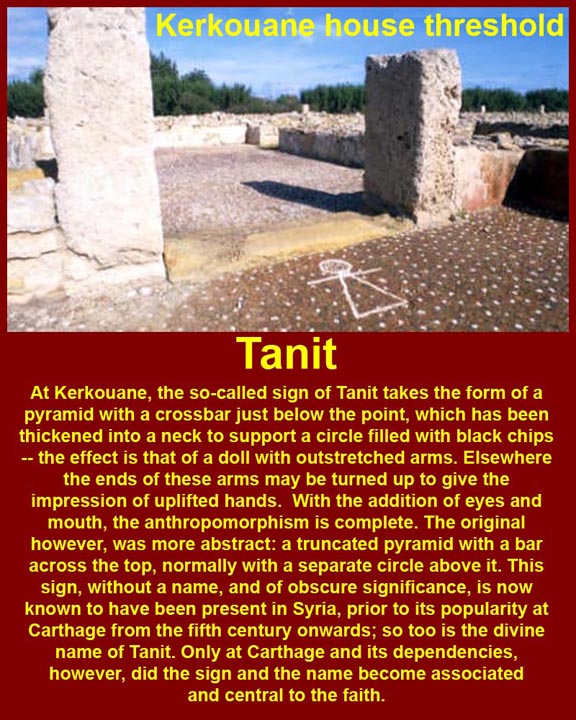
http://www.mmdtkw.org/CNAf0224bKerkouaneTanit.jpg
The origin of the icon associated with Tanit is obscure, but it is clear that early versions of the icon were much less anthropomorphic than later ones. Originally, there was an isosceles triangle with a bar across the top with a separated circle above. Some theorists say that the symbol first was an idiograph of Baal Hammon (a bull with a solar disk). But Astarte is also often shown horned with a solar disk (= Hathor, the Egyptian cow goddess). At any rate, early on in the history of Carthage, the icon was taken to indicate Tanit, identified with Astarte.
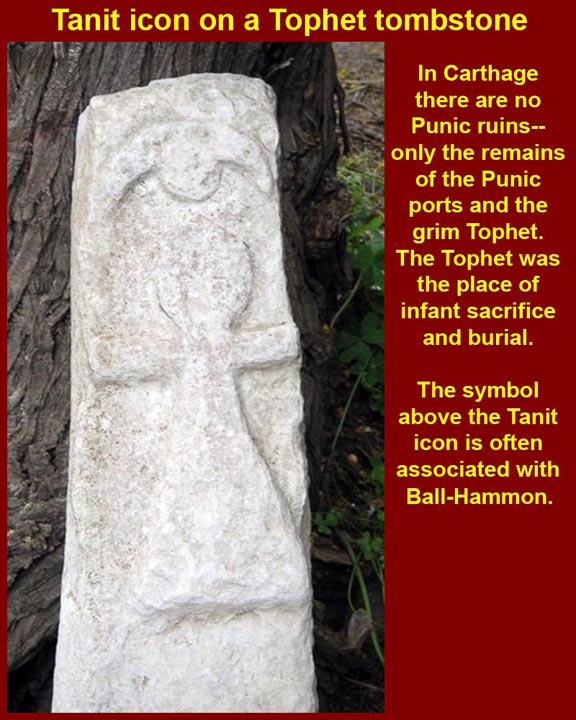
http://www.mmdtkw.org/CNAf0225aTanitTophet.jpg
Tanit on a tombstone from the Carthage Tophet -- the burial place for infant sacrifices and burials. In this instance, there is a separate idiograph that is identified with Astarte. The question is, of course, whether this is evidence that Tanit is Astarte, or perhaps has a separate identity that is denoted by separate icons.
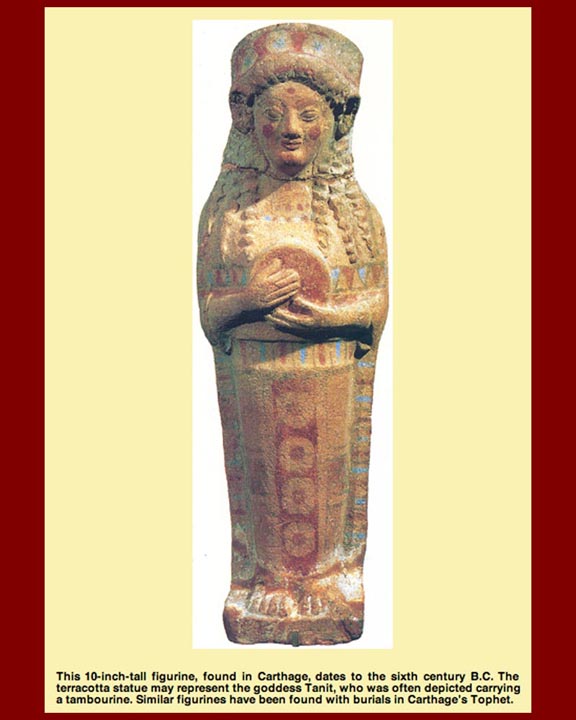
http://www.mmdtkw.org/CNAf0225bTanitTerraCotta.jpg
A small (10 inch) terra-cotta "Tanit" -- holding, once again, the tambourine. Although this one was unearthed in urban Carthage, similar statues have been found with infant burials in the Tophet.
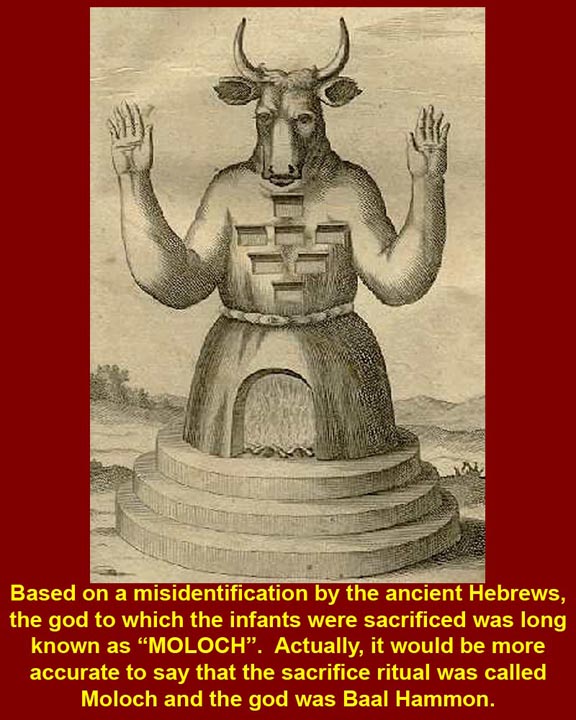
http://www.mmdtkw.org/CNAf0226Moloch.jpg
There are no ancient images of the sacrificial alter on which Carthaginian children were burned. This is an early modern German rendition, based on historic descriptions. Some descriptions speak of a grate held in the arms of the statue of Baal Hammon which, as some point during the ceremony, would mechanically tip the child into the flames.
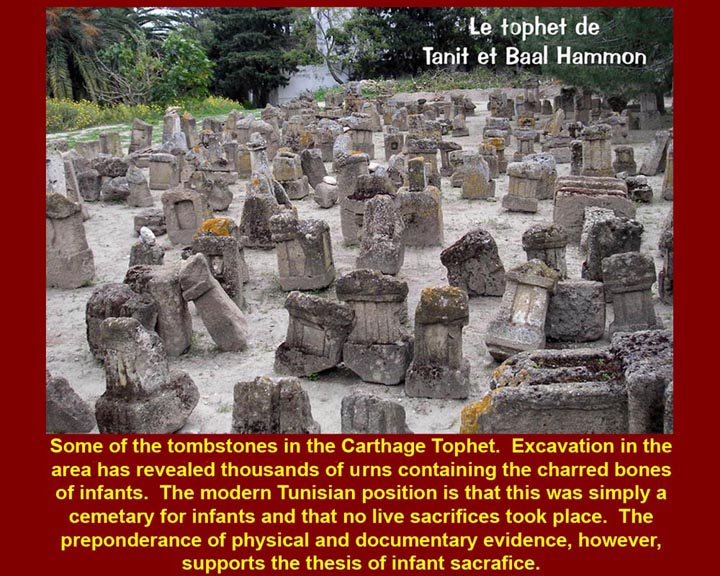
http://www.mmdtkw.org/CNAf0227aCarthageTophet.jpg
The word Tophet seems to be derived either from a Semitic for drum -- drums were beaten to cover the screams of sacrificial infants (hence the drum carried by Tanit) or perhaps from another Semitic word associated with burning. Under the massed tombstones are thousands of urns containing the charred remains of infants and (presumably by replacement) small animals.
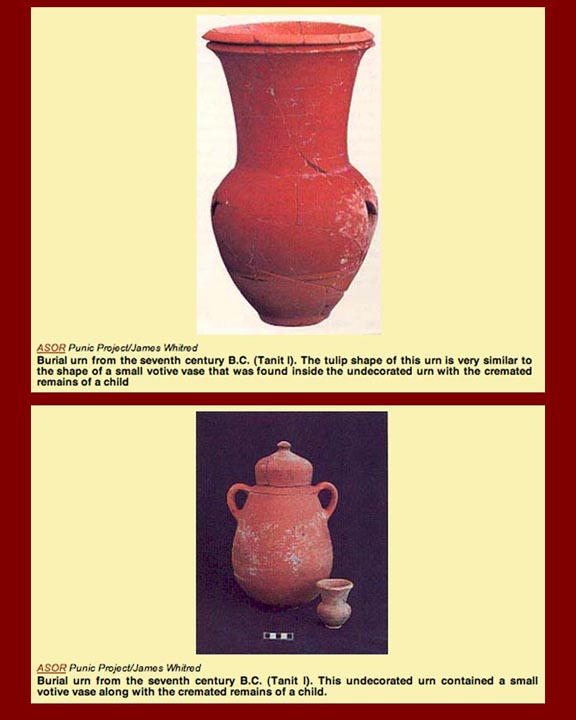
http://www.mmdtkw.org/CNAf0227bCarthageTophetUrns.jpg
Urns from the Carthaginian Tophet.
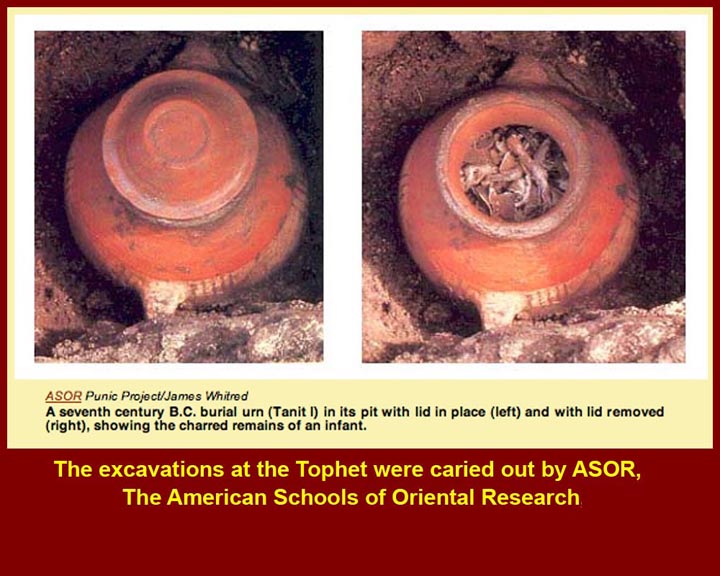
http://www.mmdtkw.org/CNAf0227cCarthageTophet.jpg
ASOR excavation photos of an infant sacrifice urn from the Carthage Tophet. ASOR is the American Schools of Oriental Research (http://www.asor.org/).
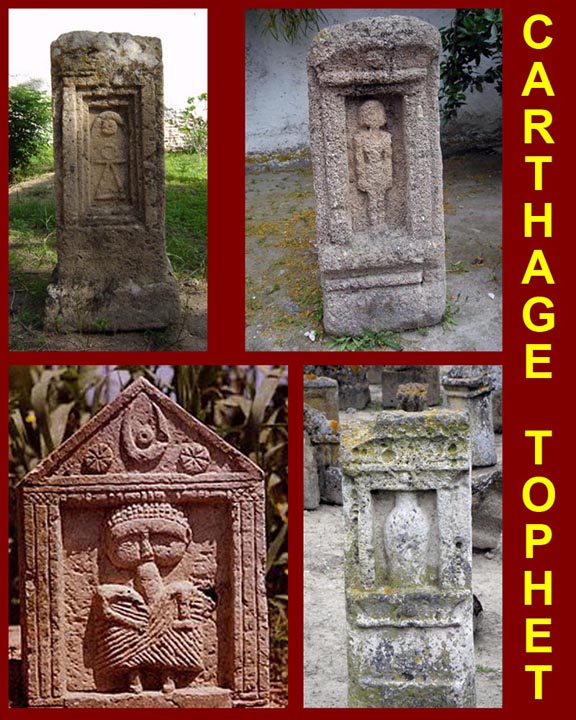
http://www.mmdtkw.org/CNAF0228Karthago_Tophet.jpg
Individual tombstones in the Carthage Tophet. The most intricate grave markers have been moved to the Bardo Museum in Tunis city.
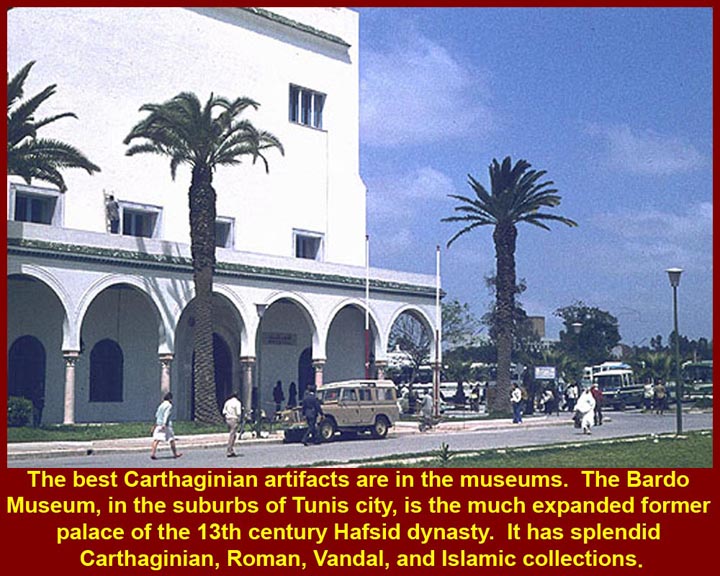
http://www.mmdtkw.org/CNAf0229BardoExterior.jpg
The Bardo Museum has prehistoric, Punic, Roman, Vandal, and islamic collections. It is housed in the much expanded 13th century royal palace of the Hafsid dynasty.
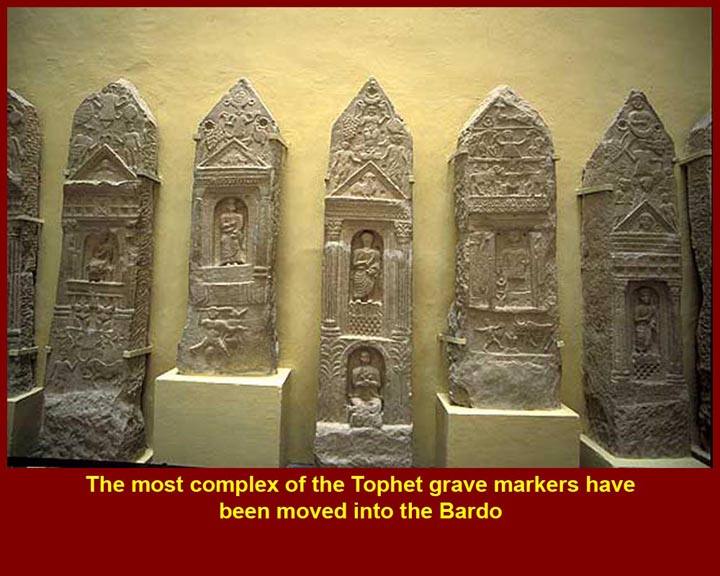
http://www.mmdtkw.org/CNAf0230BardoTombstones.jpg
Some of the more tombstones from the Tophet that are displayed in the Bardo.
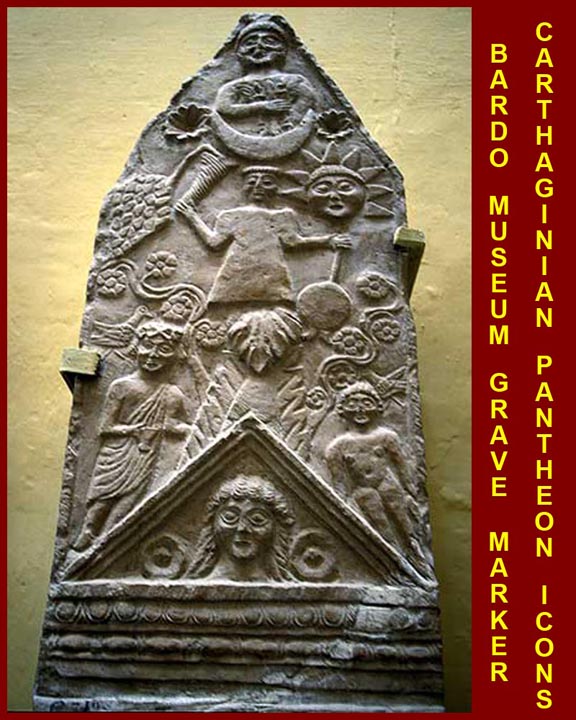
http://www.mmdtkw.org/CNAf0231aBardoPantheonTombstone.jpg
This is the upper part of the grave marker on the left of the image immediately above. It's just loaded with Punic gods and religious iconography.
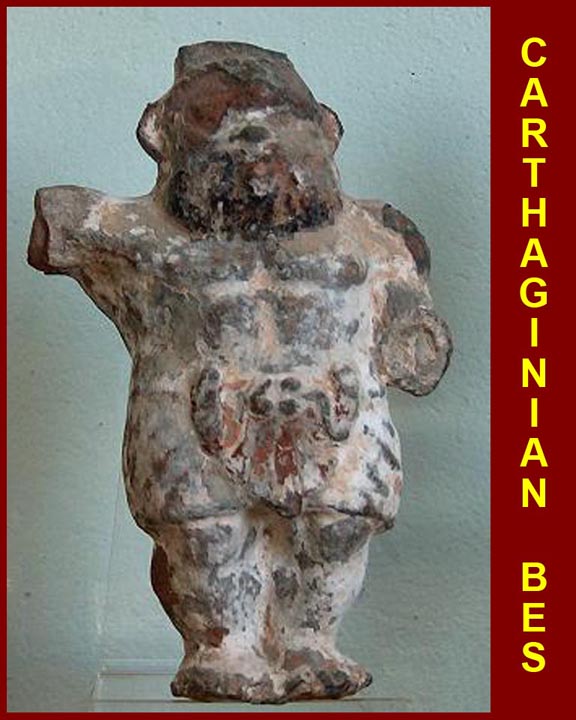
http://www.mmdtkw.org/CNAf0231bCarthaginianBes.jpg
Bes statuette found in Carthage, now in the Bardo Museum. Bes was a god recognizable as an Egyptian import, who kept demons away during childbirth. Images of Bes are found throughout Phoenician and Carthaginian territories. The Carthaginians dedicated a new town in Spain to Bes: Carthaginian Ebysos is now Spanish Ibiza.
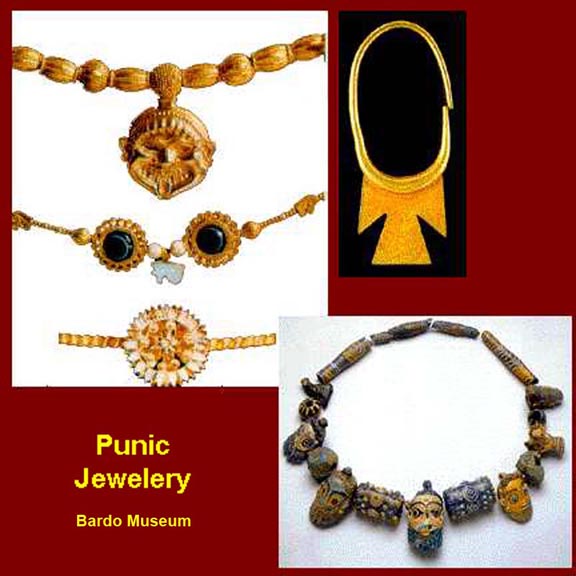
http://www.mmdtkw.org/CNAf0232PunicJewelery.jpg
Punic Jewelry from the Bardo. The earring that looks like the Egyptian ankh is a Tanit Icon. The colored necklace, lower right, has beads that look like grotesque heads -- thought to be images of minor gods or to have magic significance as amulets.
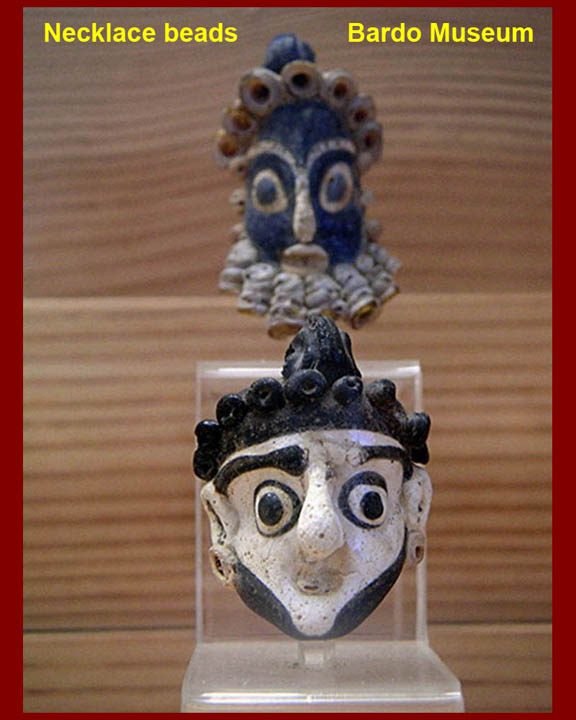
http://www.mmdtkw.org/CNAf0233aBardoHeadBeads.jpg
More amulet beads from the Bardo Museum.
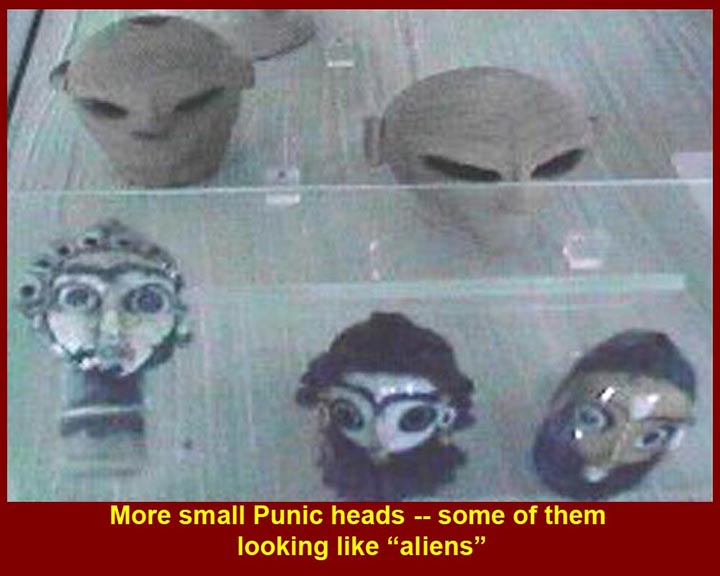
http://www.mmdtkw.org/CNAf0233bPunicCeramicHeads.jpg
Ceramic heads, some of which look like "flying saucer aliens."
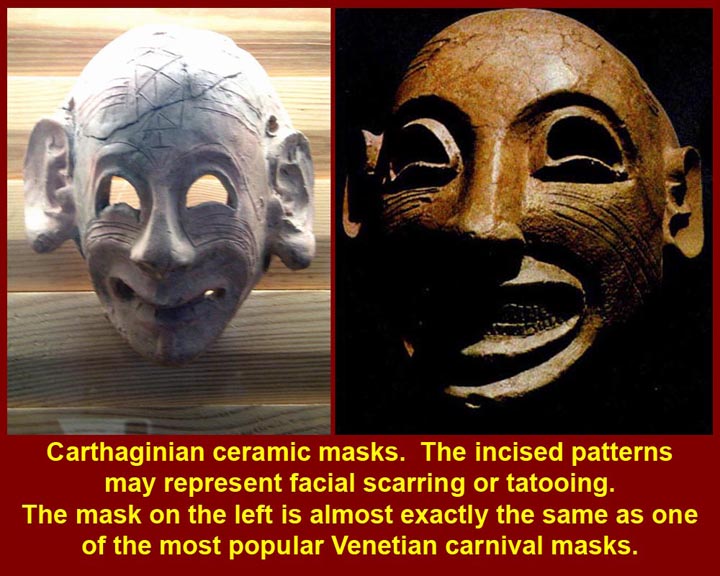
http://www.mmdtkw.org/CNAf0234BardoCeramicMasks2.jpg
Carthaginian ceramic masks. Incised decorations may indicate tattoos or scarification. Such masks are sometimes seen as evidence of sub-Saharan contact. The mask on the left is very similar to one of the Venetian carnival masks.
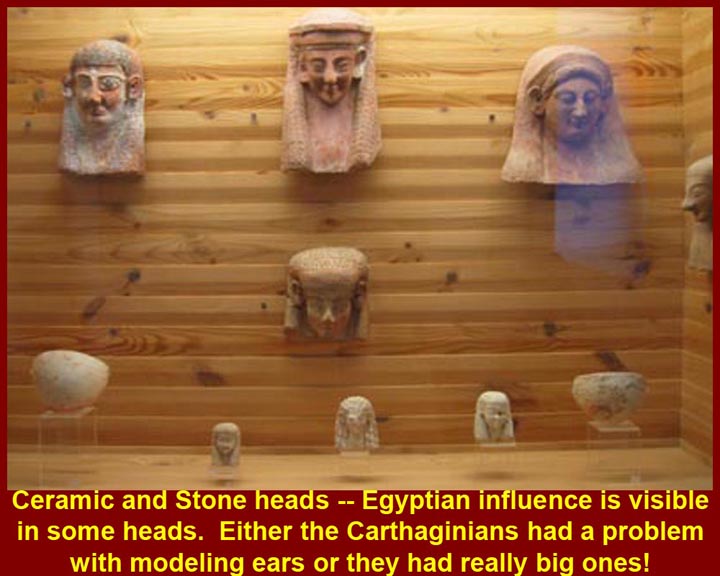
http://www.mmdtkw.org/CNAf0235BardoHeads.jpg
A display of Punic busts in the Bardo. Some show strong Egyptian influence.
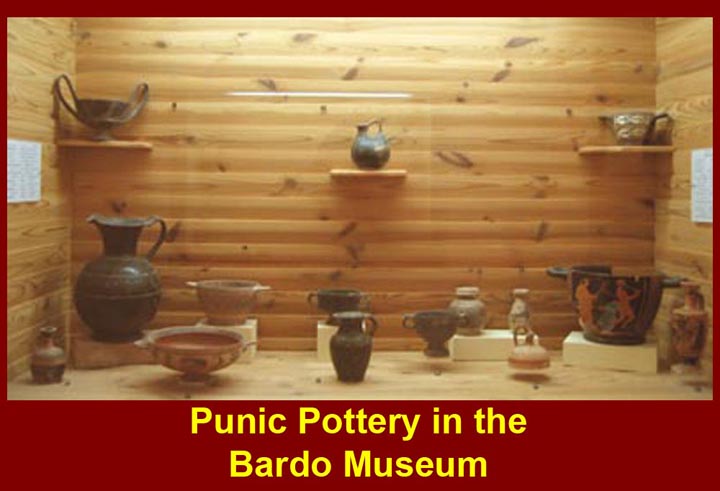
http://www.mmdtkw.org/CNAf0236BardoPunicPottery.jpg
Punic pottery, Bardo
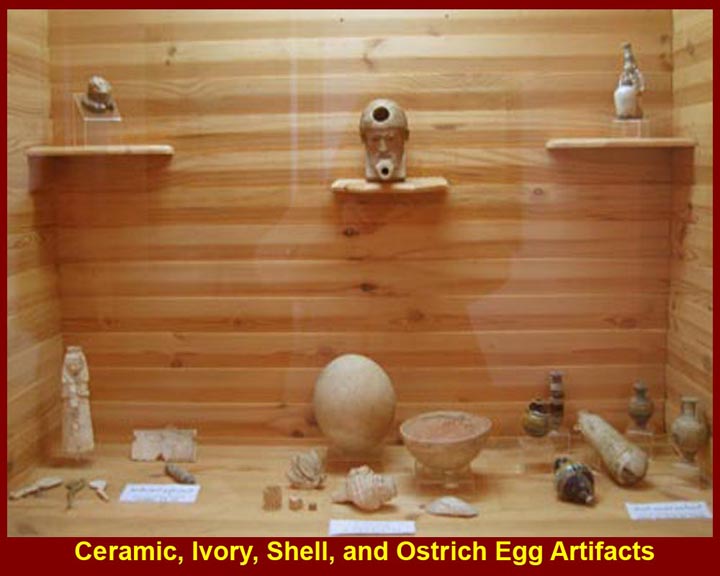
http://www.mmdtkw.org/CNAF0237BardoDivers.jpg
Punic artifacts in the Bardo made of sea shells, ceramics, and ostrich eggs. A subgroup of the aboriginal population carried bi-directional cross-Saharan trade, much as the Tuareg do today.
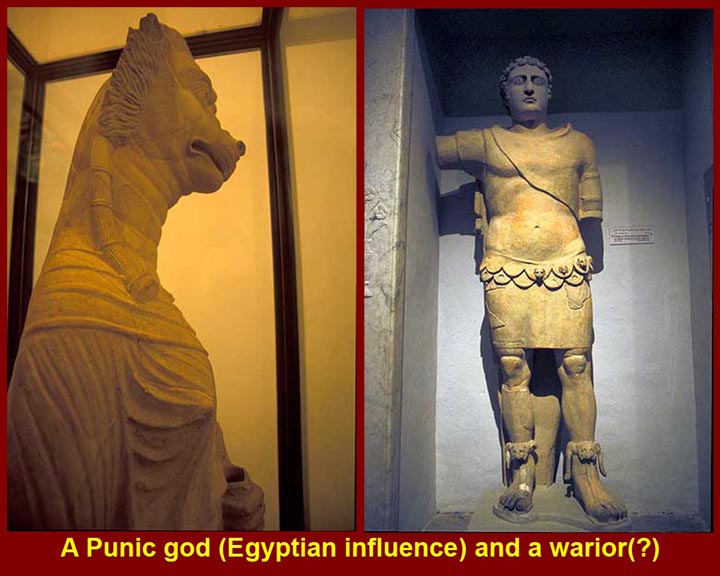
http://www.mmdtkw.org/CNAf0238GodWarior.jpg
Larger statuary in the Bardo: an "Egyptianised" god and (perhaps?) a warrior.
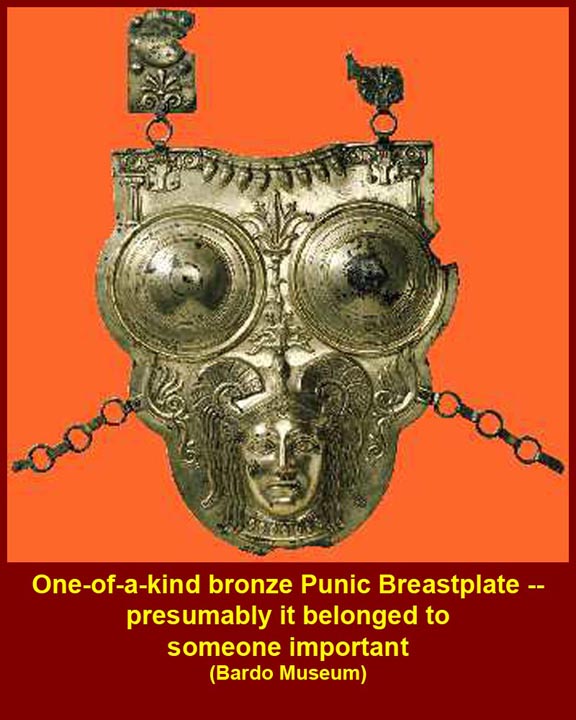
http://www.mmdtkw.org/CNAf0239Breastplate.jpg
The unique bronze Carthaginian military breastplate on display in the Bardo.
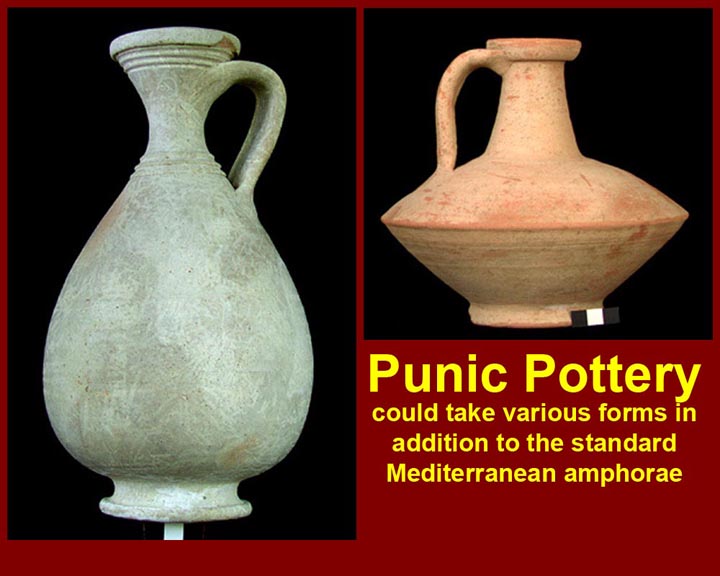
http://www.mmdtkw.org/CNAf0240PunicPots.jpg
Punic Pottery could be quite elegant or simply mundane.
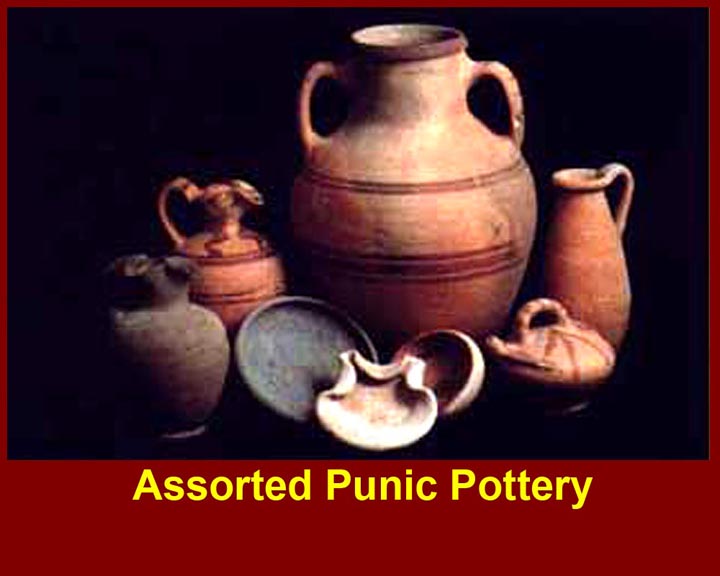
http://www.mmdtkw.org/CNAf0240aPunicPottery.jpg
A lamp, bowls, pitchers and a storage jar.
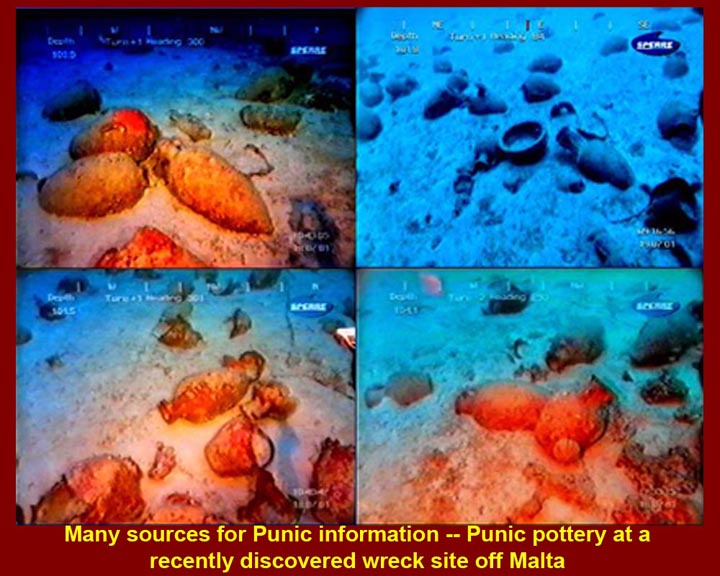 http://www.mmdtkw.org/CNAf0241MaltaPotWreck.jpg
http://www.mmdtkw.org/CNAf0241MaltaPotWreck.jpgSome of the best Carthaginian Artifacts come from underwater debris fields associated with wrecked Carthaginian ships. These are pictures taken at an underwater site off Malta.
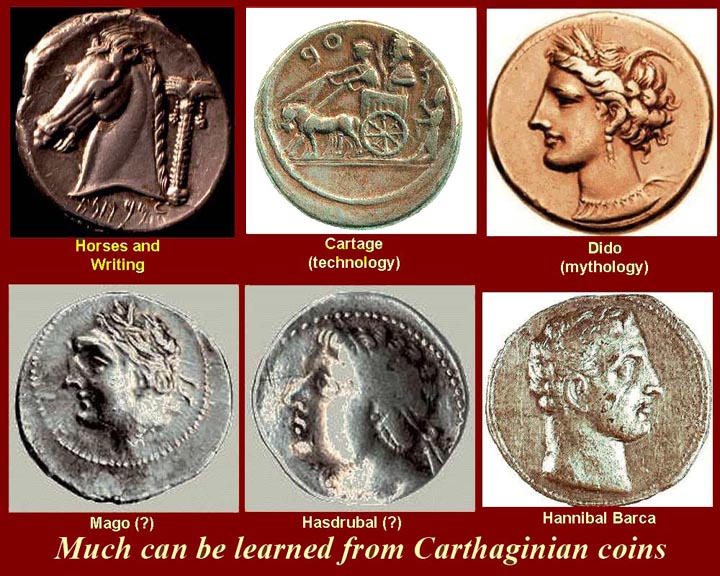
http://www.mmdtkw.org/CNAf0242Coins.jpg
Carthaginian coins, like all ancient specie, was widely circulated. The value of coins in ancient times was in the physical metal, which did not lose its value when it crossed borders or when originating countries disappeared. Coins are extremely durable and carry very much information -- everything from how the Carthaginians braided the manes of their horse, how they built wagons, attributes of their gods and goddesses, and the faces (and races) of their leaders. Unfortunately, the Carthaginians, unlike the Romans, did not use architectural imagery on their coins.
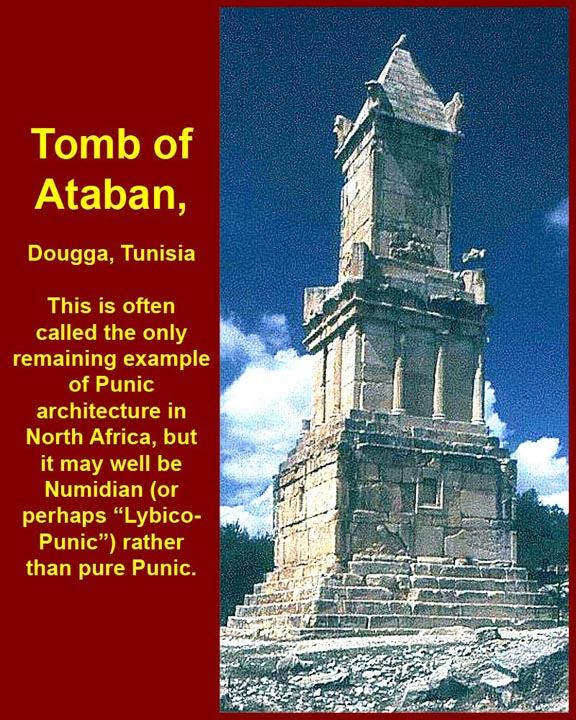
http://www.mmdtkw.org/CNAf0243AtebanTomb.jpg
The "Ateban Tomb" in Dougga, Tunisia, is either the tomb of a Numidian prince named Ateban of was designed by an architect named Ateban for a Numidian prince: what we know is that the name of Ateban is carved into the Tomb. It is touted as an example of Punic, or Numidian, of Libico-Punic architecture. It dates from the 3rd century BC and is the only known example of pre-Roman architecture that survives in the area: between purposeful destruction and materials mining, everything else was taken down.
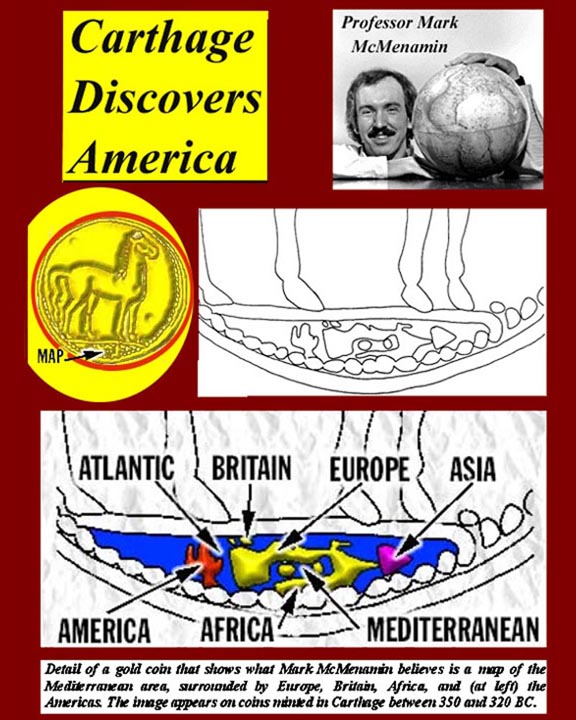
http://www.mmdtkw.org/CNAf0244CarthageDiscoversAmer.jpg
There is all kind of evidence in the Americas of Carthaginian visits and colonies -- all kinds except for any that can be scientifically authenticated.
All that needs to be said is that extraordinary claims require extraordinary proofs, none of which has been forthcoming. See http://phoenicia.org/america.html
